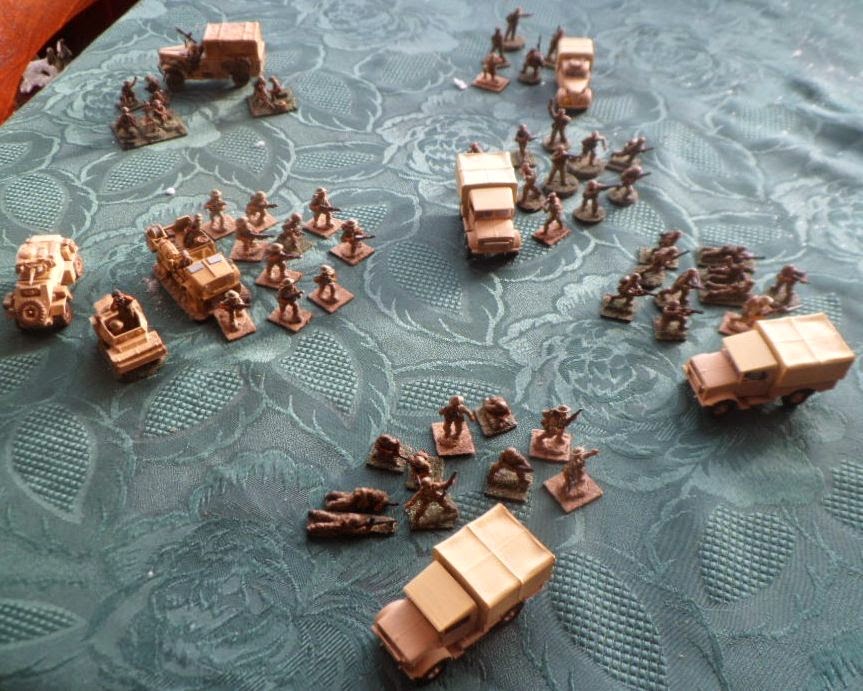This is one of those rare periods of the year when the hotel is closed and we can kick-back as a family and do as little as we want. I finally got off my arse yesterday and organised a nice quick game with the lads -
Cutting the Rail-line
from Damascus
This is a fictional scenario based on a scenario by Mark
Bevis from his WWII Battlezones scenario pack.
Background
British and Commonwealth forces inSyria are fighting the Vichy
French. Due to the lack of troops on both sides, fighting is fairly fluid with
very porous lines of battle. Historic reports of the fighting are lots of
patrol actions, encounter skirmishes and pitting an interesting variety of French
colonial units from the Armee d`Levant against British, Australian or Indian
troops and Free French forces.
British and Commonwealth forces in
The scenario
A British motorised column has slipped through the
wide-spread Vichy positions and is driving up
the Bekaa Valley
with orders to cut the rail-line between Damascus
and Beirut .
Zahle Maalaqa rail
depot
A small rail halt and water/coal station, a collection of
Arab adobe buildings clustered around the basic station with its water tower
and store houses. Bombed by the RAF a couple of days back, the station has
suffered some light damage, including several sections of damaged rail.
The locals both failed to repair the damage or inform the Vichy authorities, thus when the next train arrived from Beirut , it was forced to
stop! A juicy target for the RAF, but they are elsewhere and the train has
remained unmolested; the train commander Naval Lieutenant Patrice Soulie has
began organising rail repairs.
Lt. Soulie also dispersed his command (roughly two platoons
of naval infantry) into defensive positions against both future air attack and
possible British ground forces. Soulie also organised some local Lebanese
Gendarmerie and militia into an additional unit to back up his own men.
Lt. Soulie
2 x 9 man platoons (one w/LMG)
Hotchkiss MMG
Lebanese Gendarmerie squad – 7 men
Local militia – 10 men
Cam-Col.
Captain J. T. Cameron (“A” Squadron Royal Scots Greys) commanding a motorised strike column with orders to proceed north to Zahle Maalaqa rail depot and take/secure it and cut the rail line between Damascus and Beirut and prevent the French from redeploying units quickly be train.
Captain J. T. Cameron (“A” Squadron Royal Scots Greys) commanding a motorised strike column with orders to proceed north to Zahle Maalaqa rail depot and take/secure it and cut the rail line between Damascus and Beirut and prevent the French from redeploying units quickly be train.
Elements “B” Troop Scots Greys (mounted in trucks)
Command group (Capt. Cameron, RTO, sergeant, driver)
3 x 10 figures platoons (each with Bren)
MMG section
3” mortar section
Recce section (Humber II, Daimler scout car, Recce platoon
in truck (10 men)
Cam-col
Infantry are a mix of Airfix, Reiver, Britannia, ShellHole
Scenics, Combat Miniatures plus odd`n sods
Vehicles areOxford
di-casts, Combat Miniatures, Minimi and Britannia
Vehicles are
Vichy French forces
French naval troops
Elheim`s wonderful French colonial troops plus my own converted French Naval troops using Raventhorpe sailor bodies and their Glengarry heads
Lebanese Gendarmerie
Actually SCW Regulares, a mix of Bandera, Irregular and Tumbling Dice
Militia
A mix of Early War Miniatures and Airfix
Shots of the table
Results of the RAF raid
Coal yard
Looking towards the station from the south
Station & coal yard plus train
The whole table looking from the west
More stuff
A simple attack/defence battle; with the British arriving on
table from the eastern edge; the French forces were positioned among the
buildings and sand-bagged positions. To add a bit of stiffening to the militia the French commander split both the Militia and Gendarmes and mixed both units adding naval ratings into each sub-unit to add further backbone.
The British stayed mounted until their advance got them to
the cultivated area (marked by haystacks and the palm grove) where they came
under MG fire from the out-lying buildings; one truck was stopped and some
casualties taken and which point the British split their force – half through
the palm grove and the others across the rail line towards the coaling station.
The Humber, 3” mortar and Vickers stayed in the centre and
tried to suppress the MG and target any visible Vichy troops; several hits on the house where
the MG was located forced its crew to grab their gun and withdraw; but not
before they had wiped out the Vickers crew.
Two platoons advanced through the palm grove by section
under constant fire from naval infantry, who they eventually silenced and
turned the southern flank.
The two other platoons across the tracks, supported by the Humber and 3” mortar cleared the coaling station and
advanced upon the station from the north.
Whilst they inflicted casualties upon the various British
platoons, the Vichy
were unable to cause enough damage to check the British morale.
Once the naval infantry were lost the militia and Lebanese
Gendarmerie simply melted away………………
Unfortunately we were so involved with the game I only took
a couple of game shots -
British deploy
Half their force advance south of the railway through the
palm grove
French LMG team
Lebanese militia and Gendarmes
This was a very quickly devised game, Syria/Lebanon and Operation Exporter are fascinating, it would be quite easy to expand this game adding R35 tanks and Dodge Tanake to the Vichy side and Vickers light tanks, 2pdr portee to the Allies. The Vichy could use some Senegalese or Legionnaires from 6REI to stiffen their morale; of course the Allies could also gain Aussies, Indians or their own Legionnaires too.




































(1).jpg)


















































